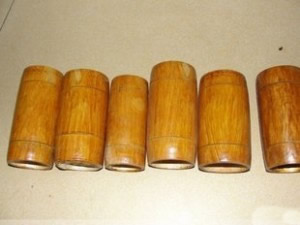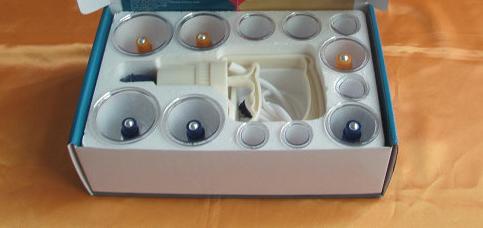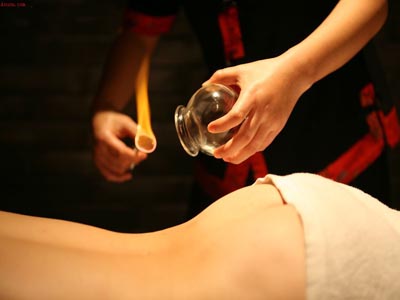拔火罐
Cupping therapy is a treatment in which a cup sucked to the skin to create local stimulation for disease treatment and prevention. The secret is the negative pressure created by consuming the air inside the cup with fire or other methods.
Cupping therapy, also known as "Jar Suction Therapy" or the "Horn Method" in ancient China, was recorded as early as in Fifty-Two Prescriptions, a silk book unearthed in Emperor Ma's tomb during the Han Dynasty. Discussions can be found in the TCM literature of other dynasties. Cupping was primarily used to drain stagnant blood and pus from carbuncles and ulcers during surgery. However, with medical progress, not only have the materials and methods of cupping therapy improved, but the scope of its indications has also greatly increased. Clinically, it often employed in conjunction with of acupuncture and moxibustion.
Types of Cups
Cups are made from a wide variety of materials, among which three types are most common used.
1. Bamboo Cups A section of firm bamboo, 3~6 cm in diameter and 6~9 cm in length, is cut to form a short cylinder. One end is used as the base; the other as the opening at the top. The rim of the cup should be made smooth with a piece of sandpaper. Bamboo cups are easily made with handy, raw materials; they are light, economical, break-resistant, and suitable for boiling. These are the good points, but the drawback is that they are prone to crack from dryness which causes air leakages that weaken their suctioning force.
2. Glass Cups These cups are shaped like a ball with smooth, open mouth. There are three different sizes: large, medium, and small. They can also be substituted with wide-mouthed cans. The glass cup is transparent, therefore, the skin in the cup can be visualized to help determine the appropriate treatment time. However, one disadvantage of glass cups is that they can shatter and are easily broken.
3. Suction Cups Presently, suction cups, for the most part, are made of plastic. Each cup has a fitting on the crown where a suctioning device is attached to remove the air. Sometimes, different sized rubber-bag suction cups are also used, Suction cups are convenient, break-resistant, safe, and the suction force can be easily regulated with very simple adjustments. Nowadays, due to these advantages, they are widely used.
Methods of Creating Suction inside the Cup
The following are popular ways of creating the negative pressure required for a cup to fix itself to a specific treatment area as the result of suction:
1. Fire Cupping Method
With this method, negative pressure is created by introducing an ignited material inside the cup to consume the air, thereby making the cup suck itself onto the skin. The following details pertain to different ways of creating suction using fire.
A. Fire-Twinkling Method Light an alcohol soaked, cotton ball held with a clamp or forceps or use a strip of paper; place it inside the cup, quickly turn it around in one to three circles and take it out immediately and press the cup on the selected area; the cup will attached itself to the skin. Presently, this is the most common used method and since no fire is retained in the cup it is relatively safe. However, caution should be taken to avoid scalds or burns by over-heating the mouth of the cup.
B. Fire-Throwing Method An alcohol soaked cotton ball or piece of paper is ignited and placed into the cup. After a short time, the cup is rapidly placed firmly against the skin on the desired location. Since there is burning material inside the cup which is apt to drop down and burn the skin, it is often applied to the lateral side of the body.
C. Alcohol-Firing Method Place one to three drops of alcohol into a cup (only a small amount should be used, to prevent it from dripping out of the cup and burning the skin. ), turn the cup to distribute the alcohol evenly on the surface of the walls. Promptly place the cup on the area to be treated after igniting the alcohol for a few seconds.
D. Cotton-Sticking Method Stick an appropriate-sized alcohol soaked, cotton ball on the inner wall of the cup; ignite the cotton ball and quickly place the cup on the area to be treated. With this method, the cotton ball should not be soaked with too much alcohol, otherwise the skin would be burned when the burning alcohol drops down.
2. Water Suction Method
With this method, the negative pressure is created when boiling water draws the air out of the cup so that it can attach to the skin. Generally, a bamboo cup is chosen to put in the boiling water or herbal liquid for several minutes; then the cup is grasped with clamped, with the mouth facing downwards. The cup is immediately placed on the selected location and attached to the body surface.
3. Suction Cup Method
A suction cup is placed firmly on the chosen area, where a device is used to withdraw the air. When a sufficient amount of negative pressure is produced, the cup will attach itself to the skin. The negative pressure can be adjusted according to the quantity of air withdrawn, to regulate the suction force.
Application of Cupping
1. The Cup-Retention Method This could also be called the cup-waiting method, as it involves keeping the cup on the selected location for 10~15 minutes before removal. This method is commonly used in clinic to treat general diseases.
2. Mobile / Moving Cupping This is also known as "sliding cupping". A lubricant should be applied to the skin over the treatment area prior to using this method. Once suction has been created, the cup is held and slid across the skin until it becomes rosy and congested, or even blood stagnation is seen. It's suitable for treating large, thickly-muscled areas such as the back, lumbar region and the thighs.
3. Flash / "Kiss" Cupping This method is done by rapidly placing and removing the cup repeatedly over the same place. It's extensively used to treat a variety of diseases, especially in situations where it is inadvisable to use retention cupping, such as with kids and on the cheeks of young ladies.
4. Pricking and Cupping Therapy This is also referred to as collateral-pricking and cupping. After disinfecting the treatment area, it is punctured with a three-edged needle to cause bleeding, or tapped it with a plum-blossom needle; the cup is then applied to induce more bleeding. This method may be used to treat all kinds of illness. Generally speaking, the cup is retained for 10 to 15 minutes.
5. Needle-Retention Cupping Sometimes referred to as needle cupping for short, this method is done by applying a cup over the center of the site where a needle has been inserted. The cup is removed when the skin turns rosy, congested and blood stagnation appears. This method combines cupping with acupuncture.
6. Medicinal Cupping There are actually two methods involved here. One is to boil a bamboo cup in an herbal decoction for 10 to 15 minutes and place it on the affected area; the other is to put the herbal decoction in the suction cup and apply it to the affected location. The prescription is made according to the illness, for example, herbal medicinal with the properties of dispelling wind and promoting blood circulation, such as Qiang Huo (Rhizoma et Radir Notopterygii), Du Huo (Radix Angelicae Pubesecentis), Dang Gui (Radix Angelicae Sinensis). Hong Hua (Flos Carthami), Ma Huang (Herba Ephedrae), Ai Ye (Folium Artemisiae Argyi), Chuan Jiao (Pericarpium Zanthoxyli), Mu Gua (Fructus Chaenomelis), Chuan Wu (Radix Aconit) and Cao Wu (Radix Aconiti Kusnezoffii), can be selected for treating wind-cold-damp syndrome.
The Actions and Indications for Cupping
Cupping therapy has the action of warming the meridians, invigorating qi and blood circulation, relieving blood stagnation, alleviating pain and swelling and dispelling damp and cold. With this extensive range of indications, it's commonly applied for wind cold-damp bi syndrome, lumbar pain, shoulder and back pain, aching low extremities, soft tissue sprains and contusions, common colds, headaches, cough, asthma, stomachaches, abdominal pain and dysmenorrhea.
Cup Removal
When removing a cup, it should be held in one hand, while the index finger and thumb of the opposite hand, presses the skin around the mouth of the cup, to break the seal created by the suction. In this way, the air is let in and the cup is released. If the strength of suction is too strong, it should not be pulled forcibly, to avoid injuring the skin.
Precautions
A. Generally, large, thickly muscled areas are selected. Patients should be comfortably positioned. It should be noted that cups are prone to drop off bone edges and hairy areas. To avoid the loss of suction, which will result in the cups falling off, patients should remain still when manipulating the cups.
B. Using cups of different sizes is determined by the cupping location. Flash cupping should be used on areas that are difficult for cups to stick.
C. Precautions should be taken to avoid scalding the skin. Prolonged retention and overheating of the mouth of the cup may cause blisters to arise. In the event that this occurs, small blisters should be covered with sterile gauze to avoid scraping; bigger ones should be aspirated with a sterile syringe, followed by the application of a disinfectant or sterile gauze. If there is purple or even black agglomeration left, the warm towel can be used; or we can press the local area, in order to promote the blood circulation, and relieve the symptom.
D. Cupping is contraindicated on patients with skin allergies, ulcers, or edema, as well as on the precordium and places supplied with large blood vessels. It is also contraindicated for those that have high fevers accompanied by convulsions, and on the abdominal and sacral areas of pregnant women.
Useful links:
Cupping process:
http://www.naturaltherapypages.com.au/natural_medicine/Cupping
Benefits of Massage Cupping™ Therapy:
Innovative Cupping treatments are being performed in many healthcare professions:
http://www.cuppingtherapy.org/
Chinese fire cupping:
http://www.chinahighlights.com/travelguide/chinese-medicine/fire-cupping.htm
Cupping message videos:
http://www.ebookee.net/Chinese-massage-Vacuum-therapy-cupping-massage_917172.html
TCM Treatments: Cupping vs Scraping :
http://english.caijing.com.cn/2012-10-16/112199416.html
Cancer Can Be Treated With Cupping And Sidr Honey Therapy:




